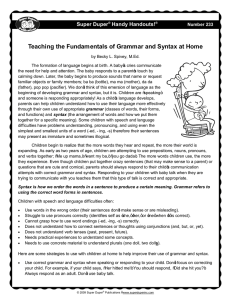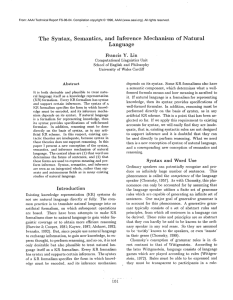Language
advertisement
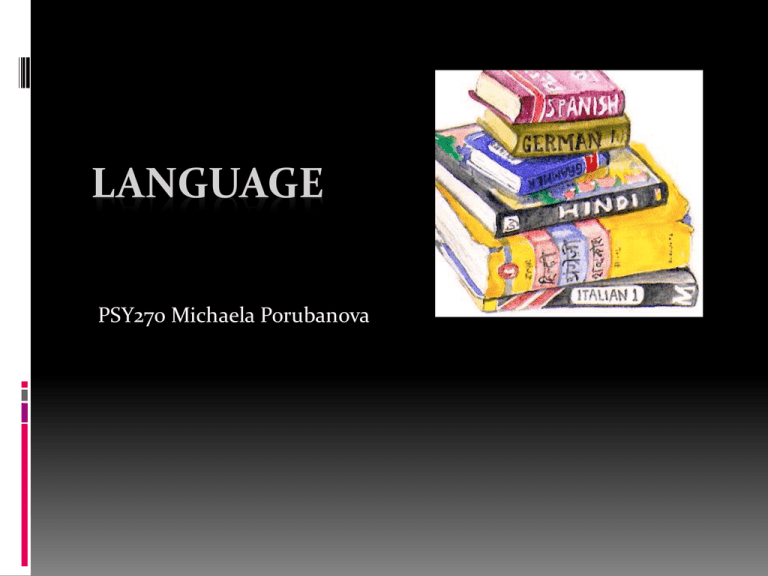
LANGUAGE PSY270 Michaela Porubanova Language a system of communication using sounds or symbols that enables us to express our feelings, thoughts, ideas, and experiences Language Phonology sound of words- systematic organization of sounds Morphology smallest unit of L with some autonomous meaning Syntax grammar rules Semantics word meanings Lexicon mental vocabulary Creativity of language new words Metaphors New combinations of words Language A, Hierarchical (combinations of elements into greater wholes) B, governed by rules ( we all implicitly know the grammar rules) C, universal (rules, language production in children) Skinner (behaviorism)- Language as entirely learned behavior Noam Chomsky- genetic grammar Psycholinguistics (comprehension, speech production & acquisition) Chomsky: Universal grammar Poverty of the stimulus (ungrammatical and incomplete input in children grammatical output) Infinite number of sentences without prior knowledge Constraints and principles cannot be learned Children start babbling early; first word 1 year; basic grammar around 6 (without the cognitive capacities to understand the grammar) Patterns of development are universal LAD language acquisition device (innate) http://www.youtube.com/watch?v=qu3XxS DRuKM&feature=related Why do we have language? Communication Adaptation Social interaction Thinking? Problem solving When is language insufficient? Language and thoughts! Do we think only using language? Does language enhance our thinking? Could we have complex, complicated thoughts without language? Does language help our ability to think? Does language limit our ability to think? Complex thoughts are ingrained in simple elements (words, concepts) Language is “labeling” our reality L is a means to solving problems Representations Computational approach to language Role of R in thinking Sapir- Whorf hypothesis The principle of linguistic relativity- the structure of a language affects the ways in which speakers are able to conceptualize their world, i.e. their world view (i) the strong version that language determines thought and that linguistic categories limit and determine cognitive categories (ii) the weak version that linguistic categories and usage influence thought and certain kinds of non-linguistic behavior Research on color perception phonemic restoration effect restoring the missing speech sound perceptually without any difficulty Inability to identify the position of coughing Top-down influence in language processing Understanding words Word-frequency effect People read high-frequency words faster than low-frequency words “Sam wore the horrid coat though his pretty girlfriend complained,” contains the high-frequency target word pretty.” (demure) Effect of the context The bankers were frightened by the walrus The Eskimos were frightened by the walrus Lexical ambiguity Understanding Sentences Semantics (N400) Syntax (P600) Parsing sentences The spy saw the man with the binoculars. (syntactic ambiguity) Late closure principle Late closure principle Garden-path model (Syntax models) Understanding of sentences based on syntax The Interactionist Approach to Parsing Both syntax and semantics help understanding the sentence when semantics comes into play? EMT- eye movement tracking Put the apple on the towel in the box. Text/discourse processing Continuity of the sentences in the story Coherence- relations between individual sentences Inferences situation model- creating a representation of a story based on locations, people and objects “Was the victim being stalked by a vampire?” readers represent story events in a manner similar to actual perception Mark Pagel on language http://www.ted.com/talks/lang/eng/mark_ pagel_how_language_transformed_humani ty.html

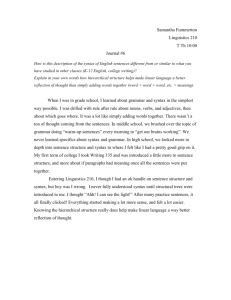
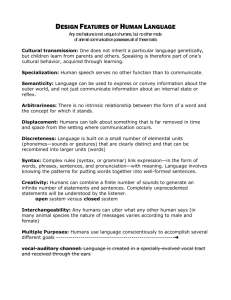



![The Word-MES Strategy[1]](http://s3.studylib.net/store/data/007764564_2-5130a463adfad55f224dc5c23cc6556c-300x300.png)
